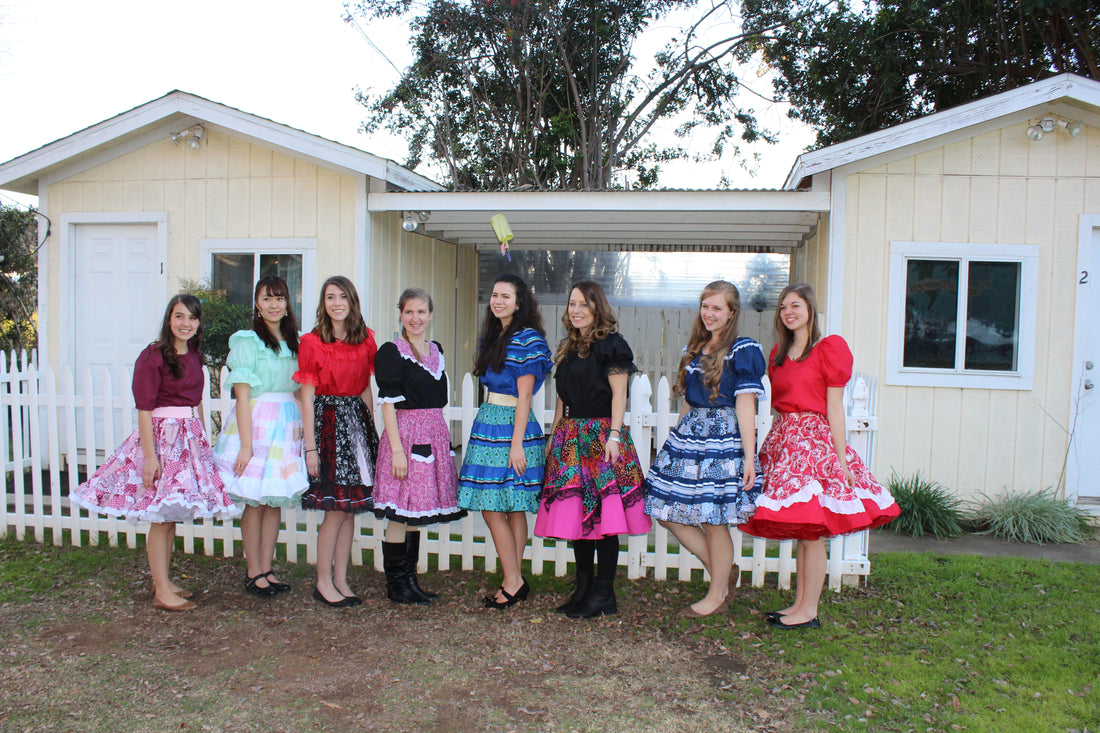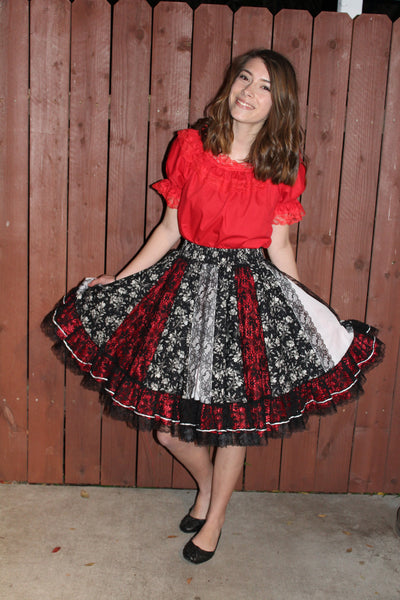
History of Square Dance: What is Square Dancing and How did it Start?
Share
History of Square Dance
Square dancing has been apart of American social life for centuries. This American folk-dance is the product of traditional dances that have gone through many changes over the years. However, the main form of square dance has not changed and is still enjoyed by millions of dancers today.
What Is Square Dance?
A Square Dance is a dance for four couples (eight dancers) arranged in a square, with one couple on each side facing the middle of the square (1).
A typical dance comprises several dances “tips,” lasting about ten minutes each, with breaks in between. The dancers line up to form “squares” at the beginning of a tip. A square has four couples arranged in a square. There may be many squares on the floor; each square of four couples works together as a team.
A “caller” stands at one end of the hall and gives a sequence of instructions for the dancers to follow. Each of these “calls” or instructions requires that some or all of the dancers in the square perform a pre-determined move. The caller does not literally tell you where to move, he/she just gives the name of the call, such as “ends fold” or “linear cycle” and the dancers will respond. Some moves are simple; others are more complex.
Although the dancers begin in a square, after each move, the formation of the dancers will change to waves, columns, diamonds, or the dancers’ position within the formation will change.
After several calls, the dancers are usually “shuffled” throughout the dance floor. Advanced callers, however, will select calls that will eventually place everyone with their original partners and back to the starting position where they started the tip.
The calls that the caller gives are set to music, so the dancers’ movements flow to the music. The music can be anything from ballads, to bluegrass, and even to rock ‘n roll.
There are two parts to a tip, lasting about five minutes each. The first part concentrates more on calls and formations, as the caller moves the dancers into a myriad of formations and positions. The second part concentrates more on the music as they choreograph the dancers' movements to a particular song. The dancers must know how to perform the moves for each of the calls (2).
Shop Square Dance Clothes
  
|
|
|
| Dresses | Blouses |
The Origin of Square Dance
Although square dancing is a unique American folk-dance, you can trace its roots from England and France. The square dance began in New England, when the first settlers and immigrants from Europe, brought with them their various national dances like the schottische, the quadrille, the jigs and reels, and the minuet, to name a few. After a hard week of carving farms and towns out of the wilderness, the settlers would gather in the community center on Saturday evening to enjoy socializing and dancing.
As the communities grew and people of different cultures intermingled, so did their dances. As their repertoire increased, it became difficult for them to remember the exact movements for each dance style. However, in any group, there would be at least one who had a knack for remembering the dance steps. This person would cue or prompt them in case they forgot what came next.
The prompter or caller would learn moves from other communities and he (usually a man) would teach them to the group. Some of these prompters developed dance routines of their own, including dances for groups of four couples, and this is how square dance was developed. As the population grew and became diverse, so did the dances.
Square dancing filled the recreational needs and provided socialization for the settlers. They only needed wooden floors, music, and the caller to enjoy dancing. As the population grew and became more urban, it also became multiracial. Booming trade brought new fashions, new music, and new dance moves from other places. New dance styles became more fashionable, and they displaced square dancing in many communities, square dancing mainly survived in isolated areas at this time.
How Henry Ford Saved Square Dance
In the early 1930s, Henry Ford became interested in reviving square dancing as a part of his project. His efforts had captured the interests of others who then modernized the activity so it would appeal to Americans while keeping its basic moves. Square dancing groups began to form, and by 1948, square dancing became popular again.
As square dance became popular again, it moved from backyards into urban centers. Name tags, worn by the dancers, put everyone on a first-name basis and created instant informality and good fellowship.
Square dancing was revived in a modern setting and spread over the nation. Today, this wholesome recreational dance is enjoyed by millions of Americans and by countless others around the world. New ideas and moves are often introduced to ensure that square dancing remains new and different every time that you go dancing.
Types of Square Dance
Quadrille
Quadrille is a classic style of a square dance. It represented a variation of square dance that originated from the French courts and the English elite class. The French brought this style in the 18th century and spread across Europe and America. Most traditional New England square dance follows this form. In Quadrille, there are well-synchronized and well-choreographed set of movements by four couples forming a square, linked to the music to its beats and led by a caller. It is performed with music that has English, French, Scottish, Irish or Irish-French feel (4).
Southern Mountain Style
Popular across the Southeastern States, this style is a unique arrangement depicting geometric formations. The arrangement of this type of square dance is not in the shape of a square but a large circle with an unspecified count of couples. This style is unique as it represents a new style (4).
Traditional Square Dance
This style makes use of the old-style movements from the 18th century which reach the US (4).
Western Square Dance
Western Square Dance was developed from the Traditional Square Dance and became popular between 1950 and 1980. The major difference between Traditional and Western Square Dance is that in Western, they randomize the calls. There is no definite set of movements that go with certain songs (4).
Modern Western Square Dance
The Modern Western Square Dance comprises two dance; the first dance part is known as a hash call in which the music is usually instrumental and the calls are rhythmically spoken. The second dance part of a square dance tip is a singing call. The dance instructions are sung well with the lyrics during the long duration of calls (4).
Maritime Canadian Square Dance
Maritime Canadian style is a unique style depicting a stretchable square, adding the couple count from five or more. This style uses the rhythms of polka and waltz, synchronized with the phrases and beats of the music (4).
Singing Square Dance
Singing square dance makes use of the movements of different styles of square dance including the Quadrille, Old Mountain Style, Traditional Style, and Western Style. This style also uses the latest songs and a caller lead and instructs the dancers (4).
Square Dance Music
Traditionally square dancing would be done only to live music. Since the 19th century, much of the square dance collection has been derived from jigs and reels. This sort of music is played on instruments, such as the fiddle, banjo, guitar double bass, piano, accordion, concertina, hammered dulcimer, saxophones, drums, and electric guitars. The music played at most dances now is from recordings.

Square Dance Dress Code
The traditional square dance attire for men includes long-sleeved western-style shirts, dress slacks, a scarf slide or bolo tie on collared shirts, and sometimes cowboy hats and boots (5).
The traditional square dance clothing for women includes a blouse, skirt, petticoat (petticoats make your skirt look full and elegant as you spin on the dance floor), belt, pettipants, and square dance shoes. Square dancers often choose coordinated square dance outfits to match their partner or group. (5).
Summary
Square dance is a product of multiple cultures but has been a part of American social life for centuries. Square dancing may have evolved and had many changes through the years but it remains an enduring part of American culture and tradition that is still enjoyed by many.
Sources:
- https://en.wikipedia.org/wiki/Square_dance
- http://www.people.vcu.edu/~jmatro/square.html
- https://www.squaredealers.com/square-dance-history/
- https://www.squareupfashions.com/blogs/news/types-of-square-dancing-7-most-popular-square-dance-styles
- https://en.wikipedia.org/wiki/Modern_western_square_dance#Dress_code



1 comment
I really enjoy the articles that you’ve had lately. Do you write them? Is it OK if I copy and pass them along to other square dancers?